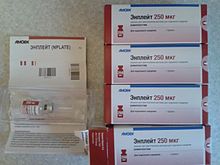Romiplostim
 | |
| Clinical data | |
|---|---|
| Trade names | Nplate, Romiplate |
| Other names | AMG531 |
| AHFS/Drugs.com | Monograph |
| MedlinePlus | a609008 |
| License data |
|
| Pregnancy category |
|
Subcutaneous | |
| ATC code | |
| Legal status | |
| Legal status | |
| Pharmacokinetic data | |
| Elimination half-life | 1 to 34 days |
| Identifiers | |
| |
| CAS Number | |
| IUPHAR/BPS | |
| DrugBank | |
| ChemSpider |
|
| UNII | |
| KEGG | |
| ChEMBL | |
| Chemical and physical data | |
| Formula | C2634H4086N722O790S18 |
| Molar mass | 59085.01 g·mol−1 |
| | |
Romiplostim, sold under the brand name Nplate among others, is a fusion protein analog of thrombopoietin, a hormone that regulates platelet production.
The drug was developed by Amgen through a restricted usage program called NEXUS.[1] During development and clinical trials the drug was called AMG531.[2]
Medical uses
Romiplostim is indicated as a potential treatment for
On August 22, 2008, the FDA approved romiplostim as a long-term treatment for chronic ITP in adults who have not responded to other treatments, such as
Clinical efficacy
In well designed, 24-week, Phase III trials, romiplostim was significantly more effective than placebo in achieving the primary endpoint of a protocol-defined durable platelet response in nonsplenectomized or splenectomized adults with chronic immune thrombocytopenic purpura.[7]
Side-effects
Romiplostim's effect is to stimulate the patient's
Experimental treatment of acute radiation syndrome
Romiplostim may be used to treat acute radiation syndrome.[8] "To reduce radiation-induced bleeding, Nplate stimulates the body’s production of platelets. The drug can be used to treat adults and children."[8]
References
- ^ a b Waknine Y (4 September 2008). "FDA Approvals: Nplate, Aloxi, Vidaza". Medscape. Retrieved 4 September 2008. Freely available with registration.
- PMID 17050891.
- S2CID 23827197.
- ^ "Amgen to Discuss Romiplostim BLA". drugs.com. 12 March 2008. Retrieved 4 November 2008.
- PMID 19386944.
- ^ "FDA Approves Nplate(TM) for Long-Term Treatment of Adult Chronic ITP" (Press release). Amgen. 22 August 2008. Archived from the original on 15 September 2008. Retrieved 4 September 2008.
- PMID 19275274.
- ^ a b Roberts L (5 October 2022). "US splashes $290m on anti-radiation drugs after Putin ups nuclear threats". The Daily Telegraph. Retrieved 10 October 2022.
